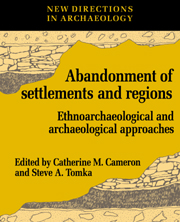Book contents
- Frontmatter
- Contents
- List of figures
- List of tables
- List of contributors
- Acknowledgments
- PART I INTRODUCTION
- PART II REGIONAL ABANDONMENT PROCESSES: ETHNOARCHAEOLOGICAL CASES
- 2 Site abandonment behavior among transhumant agro-pastoralists: the effects of delayed curation on assemblage composition
- 3 Settlement organization and residential variability among the Rarámuri
- 4 Occupational and locational instability in arid land settlement
- 5 Models of abandonment and material culture frequencies
- 6 Agricultural abandonment: a comparative study in historical ecology
- PART III REGIONAL ABANDONMENT PROCESSES: ARCHAEOLOGICAL CASES
- PART IV ABANDONMENT PROCESSES WITHIN SITES: ETHNOARCHAEOLOGICAL CASES
- PART V ABANDONMENT PROCESSES WITHIN SITES: ARCHAEOLOGICAL CASES
- PART VI CONCLUSIONS
- Index
6 - Agricultural abandonment: a comparative study in historical ecology
Published online by Cambridge University Press: 23 May 2010
- Frontmatter
- Contents
- List of figures
- List of tables
- List of contributors
- Acknowledgments
- PART I INTRODUCTION
- PART II REGIONAL ABANDONMENT PROCESSES: ETHNOARCHAEOLOGICAL CASES
- 2 Site abandonment behavior among transhumant agro-pastoralists: the effects of delayed curation on assemblage composition
- 3 Settlement organization and residential variability among the Rarámuri
- 4 Occupational and locational instability in arid land settlement
- 5 Models of abandonment and material culture frequencies
- 6 Agricultural abandonment: a comparative study in historical ecology
- PART III REGIONAL ABANDONMENT PROCESSES: ARCHAEOLOGICAL CASES
- PART IV ABANDONMENT PROCESSES WITHIN SITES: ETHNOARCHAEOLOGICAL CASES
- PART V ABANDONMENT PROCESSES WITHIN SITES: ARCHAEOLOGICAL CASES
- PART VI CONCLUSIONS
- Index
Summary
On the Nigerian savanna between Lafia and Shendam are thousands of farmsteads of sorghum, millet, and yam farmers. The area south of the small town of Namu is populated largely by Kofyar, who have been moving there from the hills of the Jos Plateau since the middle of this century. The Kofyar first came on a seasonal basis, living in ephemeral compounds, but by the time I came in 1984 they had established enduring settlements in many areas.
I had come to study the Kofyar settlement system, and I began by learning the local geography, especially the names of the various ungwas, or neighborhoods. While most of the place names were in Kofyar or Hausa, I would occasionally encounter names that referred to the Tiv, a tribe that had moved into the Namu area from the south. Place–names such as Koprume contained a small slice of settlement history – kop being the Kofyar term for the former residence of someone, Rume being the name of the Tiv who had abandoned the area. In fact, it turned out that our own compound had originally been built by Tiv and later abandoned.
Since a focus of my research was the evolution of settlement patterns, including the factors affecting farm abandonment, I was intrigued by the permanency of Kofyar settlement in precisely the same locales where Tiv settlement had been ephemeral. Kofyar and Tiv had apparently occupied the same ecological niche, clearing fields with fire and growing yams and interplanting millet and sorghum.
- Type
- Chapter
- Information
- The Abandonment of Settlements and RegionsEthnoarchaeological and Archaeological Approaches, pp. 74 - 82Publisher: Cambridge University PressPrint publication year: 1993
- 12
- Cited by



